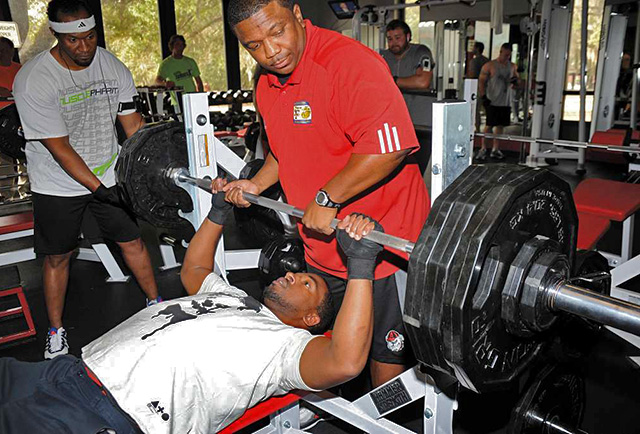This is a specific repetition maximum (RM) test for the upper body, using the bench press exercise. The one repetition maximum tests (1-RM) is a popular method of measuring isotonic muscle strength. It is a measure of the maximal weight a subject can lift with one repetition. You might want to pair this test with the squat or deadlift lower body max test. See the general description of 1RM fitness tests.
 1RM bench press exercise
1RM bench press exercise test purpose: to measure maximum strength of the chest muscle groups.
equipment required: Bench with safety bar, barbell and various free weights.
pre-test: Explain the test procedures to the subject. Perform screening of health risks and obtain informed consent. Prepare forms and record basic information such name, age, height, body weight, gender, test conditions. Check equipment for safety and calibrate if required. See more details of pre-test procedures.
procedure: The subject should perform an adequate warm up. An example would be to warm up with 5-10 reps of a light-to-moderate weight, then after a minute rest perform two heavier warm-up sets of 2-5 reps, with a two-minute rest between sets. The subject should then rest two to four minutes, then perform the one-rep-max attempt with proper technique. If the lift is successful, rest for another two to four minutes and increase the load 5-10%, and attempt another lift. If the subject fails to perform the lift with correct technique, rest two to four minutes and attempt a weight 2.5-5% lower. Keep increasing and decreasing the weight until a maximum left is performed. Selection of the starting weight is crucial so that the maximum lift is completed within approximately five attempts after the warm-up sets. See the Bench Press Example Videos.
scoring: the maximum weight lifted is recorded. To standardize the score it may be useful to calculate a score proportional to the person's bodyweight. The sequence of lifts should also be recorded as these can be used in subsequent tests to help in determining the starting lifts. See the table for general guidelines for interpreting the results. These ratings are for both males and females - as females are generally a smaller frame, there are expected to lift a lower actual weight to score an average rating etc. These scores are based on my personal experiences. There are also some athlete results for this test and a calculator to estimate 1RM.
| 1 Rep Max Bench Press Table for adults (weight lifted per bodyweight) |
|
| Rating | Score (per body weight) |
|---|---|
| Excellent | > 1.60 |
| Good | 1.30 - 1.60 |
| Average | 1.15 - 1.29 |
| Below Average | 1.00 - 1.14 |
| Poor | 0.91 - 0.99 |
| Very Poor | < 0.90 |
advantages: the required equipment is readily available in most gymnasiums, and the test is simple to perform.
disadvantages: This test should only be performed by those experienced at performing the bench press lift with good technique. Good technique will also enable the lifter to maximize their score.
comments: For safety, a spotter should stand at the head of the bench throughout the test. The results of this test may be specific to the equipment used (height of bench, variations in weights), so is best to use the same equipment for test-retest measures. The warm up procedure should also be recorded and repeated with further testing. If any variation in technique was allowed, this should be recorded on the results sheet for referral when the test is repeated. The test is also called one rep max, 1-RM, and one repetition maximum.
variations / modifications: Sometimes a three or five repetition maximum is used, particularly for less experienced lifters. These greater reps would require less weight and may be considered less dangerous. Changing the number of repetition also changes the muscle energy systems and validity of this test.
Similar Tests
- Repetition Max Deadlift Test — maximum lift for one squat repetition.
- Lat Pulldown 1-Rep Max Test — one-repetition max test using the lat pulldown exercise.
- Squat 1RM — maximum lift for one squat repetition.
- Bench press maximum fitness test — perform as many bench presses as they can at a particular weight.
- Relative bench press test— perform the maximum number of bench presses at a set % of their body weight.
- 1-RM Tests — measure of the maximal weight a subject can lift with one repetition.
Related Pages
- A calculator to estimate 1RM.
- More about Bench Press Fitness Testing
- The Sport of Power Lifting Bench Press
- Reps in Reserve (RIR) — how many more can you do?
- See video examples of bench press testing in action.
- Some athletes results for the 1RM Bench Press
- General description of 1RM fitness tests
- Using 80% of 1RM to estimate muscle fiber composition
- Powerlifting Bench Press Sport
- Measuring body mass
- Bench press technique
- World Records for the Bench Press


 Current Events
Current Events